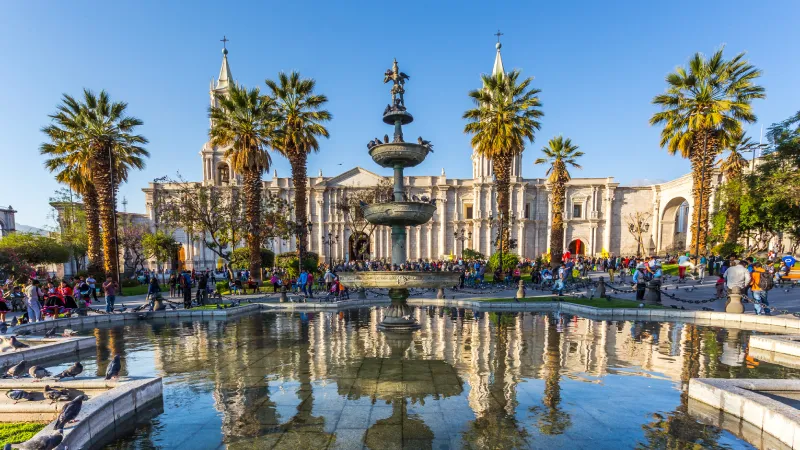
Arequipa: The best places and activities for your trip.
Arequipa, also known as the White City, is one of the most important and beautiful cities in Peru. Located in the south of the country at the foot of the majestic Misti Volcano, Arequipa is notable for its colonial architecture built with white sillar, a volcanic stone that gives the city its distinctive color.
Table Of Content
- What should you see and do in Arequipa?
- Arequipa Main Square
- What can you do at Arequipa’s Plaza de Armas?
- Arequipa Cathedral
- History
- Architecture
- It has religious and cultural importance
- Additional information
- The main activities at the Arequipa Cathedral
- Visit the Cathedral Museum
- Climb the bell tower
- Attend a mass
- Take photos in the Plaza de Armas
- Learn with a tour guide
- Practical Information
- Misti Volcano
- Here are some tips for climbing the Misti volcano
- Physical Condition
- Risks to Consider
- Respect the mountain
- Monastery of Saint Catherine
- History of the Monastery of Santa Catalina
- Architecture and Style
- Art and Culture
- Visit the monastery
- Recommendations for your visit
- Cultural Importance
- San Lázaro neighborhood
- History of the San Lázaro Neighborhood
- What can you see and do in San Lázaro?
- Architectural Style
- Visiting Tips
- Interesting Facts
- Yanahuara Viewpoint
- Location
- History of the Yanahuara Lookout
- What can you see from the viewpoint?
- Things to Do in the Area
- Useful Information
- Recommendation
Founded in 1540, the city’s historic center was declared a UNESCO World Heritage Site in 2000 thanks to its well-preserved colonial architecture. One of its most iconic sites is the Monastery of Santa Catalina, a convent city that transports visitors back to the 16^(th) and 17^(th) centuries.
Arequipa is also an important cultural and culinary center. Its cuisine is one of the most renowned in the country and features dishes such as rocoto relleno (stuffed rocoto pepper), adobo arequipeño (Arequipa-style adobo), and shrimp stew.
Arequipa is also an ideal starting point for exploring natural wonders like the Colca Canyon, one of the deepest canyons in the world and home to the majestic Andean condor.
With its sunny climate almost year-round and blend of history, vibrant culture, and breathtaking landscapes, Arequipa undoubtedly captivates all its visitors.
What should you see and do in Arequipa?
Arequipa Main Square
The Plaza de Armas in Arequipa is the city’s nerve center. The plaza is surrounded by colonial buildings constructed from white ashlar, a volcanic stone characteristic of the region. The north side features an imposing Neo-Renaissance cathedral with two tall towers. The other three sides have arched portals that house cafés, restaurants, and offices.
In the center of the plaza stands an ornamental bronze fountain featuring a sculpture of a traditional figure known as the Tuturutu. From the plaza, you can see the Misti, Chachani, and Pichu Pichu volcanoes, which frame the cityscape.
The plaza is a popular meeting place for locals and tourists and a great starting point for exploring Arequipa’s historic center.
What can you do at Arequipa’s Plaza de Armas?
You can visit the cathedral and climb to the observation deck.
Stroll through the colonial portals.
Dine at restaurants with views of the plaza.
Take photos with the Misti Volcano in the background.
See the Tuturutu fountain.
Relax on a bench and enjoy the atmosphere.
Finally, join a guided tour of the historic center.
Arequipa Cathedral
The Arequipa Cathedral, located in the Plaza de Armas in Arequipa, Peru, is one of the country’s most important religious monuments. It is a symbol of the region’s colonial and cultural legacy. Below, I provide an overview of its history, architecture, and significance.
History:
Original Construction: Construction began in 1540, the same year that Arequipa was founded. However, the building was damaged by earthquakes and the eruption of the Misti volcano.
The final reconstruction, overseen by Peruvian architect Lucas Poblete, was completed in 1844.
The cathedral has undergone several restorations due to major earthquakes, including those in 2001 and 2016.
Architecture:
Style: Neo-Renaissance with Gothic influences.
Materials: It is primarily built of ashlar, a white volcanic stone typical of the region. This is why the city is nicknamed “The White City.”
Dimensions: It occupies nearly an entire side of the Plaza de Armas, a feature that sets it apart from other South American cathedrals.
Inside, visitors can admire an impressive high altar, a carved pulpit, and a large Belgian organ, which is considered one of the largest in the Americas.
It has religious and cultural importance
It is the seat of the Archdiocese of Arequipa.
The city has witnessed significant historical, religious, and political events.
It symbolizes the cultural fusion between Europe and the Andes.
Additional information:
Location: Arequipa’s Plaza de Armas.
Visiting hours: Generally open to the public during Mass and sightseeing, although these hours may vary.
The cathedral museum offers guided tours where you can learn about the church’s history, view liturgical artifacts, and climb the bell tower.
The main activities at the Arequipa Cathedral
Take a tour of the cathedral
Admire its impressive Neo-Renaissance architecture.
Take note of details such as the main altar, the carved wooden pulpit, and the Belgian organ.
Take in the use of Arequipa’s signature white ashlar stone.
Visit the Cathedral Museum
You can enter through the side entrance.
The museum displays a collection of sacred art, including paintings, liturgical vestments, gold and silver chalices, and colonial objects.
Learn about the church’s history and its role in the city.
See the magnificent pipe organ, one of the largest in South America, up close.
Admission includes a guide in Spanish or English.
Climb the bell tower
Climb the cathedral towers and admire the historic bells.
Enjoy one of the best views of the Plaza de Armas, the Misti Volcano, and part of the historic center.
It’s the ideal place to take panoramic photos of Arequipa.
Attend a mass
If you’re interested in the spiritual aspect, you can attend one (check the schedule).
Sunday Masses usually feature organ music and choirs.
Take photos in the Plaza de Armas
The cathedral is spectacular at night, when it is illuminated.
You can also take excellent photographs from the doorways and balconies of nearby cafés.
Learn with a tour guide
Guided tours include the Cathedral and other monuments in the historic center.
It’s ideal if you’re interested in colonial history, architecture, or religion.
Practical Information:
Admission to the museum and bell tower: fee (approximately 10-20 soles, subject to change).
Hours:
Museum: Monday through Saturday, morning and afternoon.
The cathedral is open during Mass and for sightseeing, but it is recommended to avoid religious service hours.
The complete visit takes approximately 1.5 to 2 hours.
Misti Volcano
The Misti Volcano, located near Arequipa, Peru, is a sacred mountain and one of the region’s most important symbols. Since pre-Inca times, it has been considered an apu, or a protective deity. During the Inca Empire, religious rituals such as the Capacochá were performed at its summit and included human sacrifices. Even after the arrival of the Spanish, the volcano maintained its symbolic importance, and its volcanic stone, sillar, was used to build much of the city of Arequipa.
During the republican era, the Misti Volcano solidified its status as a cultural and geographical icon. Scientifically, it is considered an active, dormant volcano; its last major eruption occurred around the 15th century. Due to its proximity to a densely populated city, it is constantly monitored and is also a popular tourist destination for mountaineers.
The Misti volcano is not only a natural feature, but also a deeply rooted cultural, spiritual, and historical figure in the Arequipa identity.
Here are some tips for climbing the Misti volcano:
Acclimate first
Spend at least two or three days in Arequipa, which is 2,300 meters above sea level, before beginning the ascent.
This will reduce the risk of altitude sickness, or soroche.
Hire a certified guide
While it’s not mandatory, it’s highly recommended.
The terrain is difficult and the weather can change quickly.
Guides know the best routes and safety protocols.
Best Time to Climb:
April to November, during the dry season with clear skies.
Avoid climbing during the rainy season (December to March) due to the risk of storms and reduced visibility.
Duration of the climb:
Generally, two days and one night.
Day 1: Transportation to the starting point, followed by a hike to base camp (approximately 4,500 m).
Day 2: Early morning ascent to the summit (19,100 ft) and descent.
Necessary equipment:
Trekking backpack (40-50 liters).
Layered thermal clothing (down to -10°C at night).
Windbreaker/raincoat
Sturdy trekking boots.
Trekking poles.
Hat, gloves, sunglasses, and sunscreen.
A headlamp with spare batteries.
A sleeping bag for extreme cold (below -10°C).
Thermal insulation and a tent (if not traveling with an agency).
Energy snacks such as nuts, bars, and chocolates.
Bring a minimum of three or four liters of water per person, as there are no water fountains along the route.
Physical Condition:
This is a demanding hike with steep inclines, high altitudes, and volcanic sand that makes walking difficult.
If you’re not accustomed to such conditions, practice with long uphill walks before your trip.
Risks to Consider:
Altitude sickness: Symptoms include headache, nausea, and fatigue. Descend slowly if symptoms are severe.
Hypothermia: Dress in layers and avoid excessive sweating.
Dehydration: Drink water regularly, even if you’re not thirsty.
Extreme fatigue: The terrain is sandy, so each step is more difficult. Walk slowly and steadily.
Respect the mountain
Don’t leave trash behind.
If you find archaeological artifacts, leave them where they are.
Treat Misti with the same respect that the locals have for it. It is an integral part of their culture and history.
Final recommendation:
If this is your first hike above 5,000 meters, Misti is an excellent challenge, but don’t underestimate it. Hiking with a guide and in an organized group greatly increases safety and enjoyment.
Monastery of Saint Catherine
The Monastery of Saint Catherine of Siena, located in the heart of Arequipa’s historic center in Peru, is one of the most important and unique colonial religious monuments in Latin America. Its history, architecture, and monastic life make it a must-see for travelers.
History of the Monastery of Santa Catalina
Founded on September 10, 1579, by María de Guzmán, a wealthy Arequipeña widow, the monastery was established shortly after the city’s founding. It was established as a cloistered monastery for Creole, mestizo, and Spanish women from wealthy families.
For more than three centuries, the convent remained closed to the public. The nuns lived in complete isolation from the outside world, devoting themselves to prayer and domestic work. Each nun had her own cell, often with servants, and many brought substantial dowries. This gave rise to an almost aristocratic lifestyle in the convent.
In 1970, the monastery opened its doors to the public, and part of the premises became a museum. However, a small group of nuns still reside in a reserved section.
Architecture and Style:
Built entirely of white and pink ashlar, a volcanic stone typical of Arequipa, the Monastery of Santa Catalina occupies more than 20,000 square meters. Its architecture blends colonial, Mudejar, and Andean styles.
The interior resembles a city within a city, complete with narrow streets, plazas, fountains, kitchens, laundries, chapels, and over 80 cells. Among the most notable spaces are:
Zocodover Plaza, where the nuns gathered to converse;
The Main Chapel, which houses a beautiful Baroque altar.
The Orange Tree Cloister is a peaceful place surrounded by trees and frescoed murals.
The cells are also noteworthy, as they are decorated with original objects and furniture from the 17th and 18th centuries.
Art and Culture
The monastery houses a rich collection of viceregal art, especially religious paintings from the Cusco and Arequipa schools, as well as sculptures, liturgical ornaments, and everyday objects that depict monastic life of the period.
Visit the monastery
Address: 301 Santa Catalina Street. It is located one block from Arequipa’s Plaza de Armas.
Hours: Open daily from 9:00 a.m. to 5:00 p.m., with extended hours on some nights.
Admission: Fee applies. Discounts are available for national and international students.
Guided tours: Highly recommended (in Spanish, English, French, and other languages).
Duration: One and a half to two hours.
Recommendations for your visit:
Wear comfortable shoes, as the monastery is large and has cobblestone streets.
If possible, visit at night, when the lighting completely transforms the atmosphere and there are fewer visitors.
Pay attention to the architectural and symbolic details; many corners of the monastery are steeped in history and spirituality.
Cultural Importance:
The Monastery of Santa Catalina is a living testament to the religious lives of women during the colonial era. It reflects the intertwining of art, architecture, and spirituality in colonial Peru. Today, it is one of Arequipa’s main tourist attractions and a Peruvian cultural heritage site.
San Lázaro neighborhood
The San Lázaro neighborhood is the oldest in Arequipa and one of the city’s most picturesque areas. Located a few blocks from the Plaza de Armas, the neighborhood is steeped in history and colonial charm. It’s an ideal place for strolling, taking photos, and discovering the traditional essence of Arequipa.
History of the San Lázaro Neighborhood
Founded in the first half of the 16th century, San Lázaro predates the official founding of Arequipa in 1540. It is believed to be where the first Spaniards and mestizos settled, making it the city’s first urban settlement.
The neighborhood was named after the patron saint of lepers because a leper hospital was built there during the colonial era.
Over time, the neighborhood became a residential area with narrow streets, ashlar houses, and small squares. It has maintained its colonial atmosphere to this day.
What can you see and do in San Lázaro?
Stroll through its alleys.
The neighborhood is full of cobblestone streets, including Violin Alley.
Violin Alley.
Crystal Alley,
Bayonet Alley.
These names transport us back to the colonial era. The alleys are lined with white ashlar houses, carved wooden doors, and traditional balconies.
San Lázaro Square:
This is the heart of the neighborhood. This quiet space is surrounded by benches, lanterns, and flowers, making it an ideal place to rest or take photographs.
Photography and Art
San Lázaro is a popular spot for photographers and artists because of its light, architecture, and serene atmosphere. It’s one of the most Instagram-worthy places in Arequipa.
In recent years, cafés and galleries have opened in restored houses in the neighborhood, giving it a bohemian and modern feel while maintaining its essence.
The neighborhood has experienced a revival with the opening of cafés, boutique restaurants, and small art galleries in restored houses.
Cultural Walk.
From San Lázaro, you can walk to other places in the historic center, such as:
– Yanahuara Viewpoint.
Grau Bridge.
– Jerusalem Street
– San Francisco Street
Architectural Style:
The neighborhood maintains a Colonial Mestizo style, characterized by:
– Thick white ashlar walls.
– Vaulted ceilings.
– Small interior courtyards.
– Carved stone gates.
It is a living example of traditional Arequipa architecture that has withstood earthquakes and centuries of history.
Visiting Tips:
The best times are morning or evening, when the light enhances the colors of the ashlar.
The recommended duration is between 30 minutes and 1 hour.
Ideal for: – A leisurely stroll.
– Photography.
– Couples.
– Cultural visits.
Interesting Facts:
Many believe that the names of the streets and alleys originated from local events or ancient families.
Some of the homes are still inhabited by descendants of the original settlers.
It is common to see artists painting or performing music in the streets on weekends.
Yanahuara Viewpoint
The Yanahuara viewpoint is one of the most iconic and popular spots in Arequipa. It is famous for its spectacular views of the Misti Volcano, the city, and the surrounding areas. It is also a place steeped in Arequipa’s history, architecture, and tradition.
Location:
The viewpoint is located in the traditional district of Yanahuara, just 1.5 kilometers (about 1 mile) from Arequipa’s historic center. It is about a 15- to 20-minute walk from the Plaza de Armas or a 5-minute taxi ride.
History of the Yanahuara Lookout
The Yanahuara district, founded in the 17th century, preserves a strong colonial and mestizo legacy. Built with arches of white sillar, a volcanic stone typical of Arequipa, the lookout offers stunning views of the city and Misti Volcano.
Each arch is inscribed with famous quotes from notable figures in Peruvian history, both from Arequipa and elsewhere in the country. This makes the lookout not only a scenic spot, but also a cultural one.
What can you see from the viewpoint?
A panoramic view.
From there, you can enjoy one of the best views of the Misti Volcano.
— the Misti Volcano in all its splendor.
– The Chachani and Pichu Pichu volcanoes.
– Part of Arequipa’s historic center.
The Chili River valley.
The ashlar arches.
This colonial structure is composed of a series of hand-carved white stone arches. Each arch bears inscriptions of thoughts, poems, or reflective phrases.
Yanahuara Church.
Next to the viewpoint stands the small yet beautiful San Juan Bautista de Yanahuara church, built in 1750 in the mestizo baroque style with white ashlar stone.
Traditional Streets:
The quiet neighborhood surrounding the viewpoint has cobblestone streets, colonial houses, and wrought-iron balconies, creating a very photogenic atmosphere.
Things to Do in the Area:
Take photographs, especially at sunset.
Try homemade ice cream or traditional desserts.
Visit cafés with terraces and direct views of the Misti River.
Buy souvenirs from the nearby craft stalls.
Useful Information:
Admission: Free.
Hours: Open all day, but it’s best to visit during the day to enjoy the views.
The best times to visit are in the morning, when the sky is clear, and at sunset to see the colors of the volcano.
Recommendation:
You can include the Yanahuara viewpoint on a hike from the centre of Arequipa. The route passes the Grau Bridge and several colonial streets. It’s an ideal way to spend a relaxing afternoon, taking memorable photos and immersing yourself in the essence of Arequipa.
“Rainbow Mountain in Peru is a breathtaking natural wonder, known for its vibrant, colorful stripes that look like they’ve been painted by nature itself.”


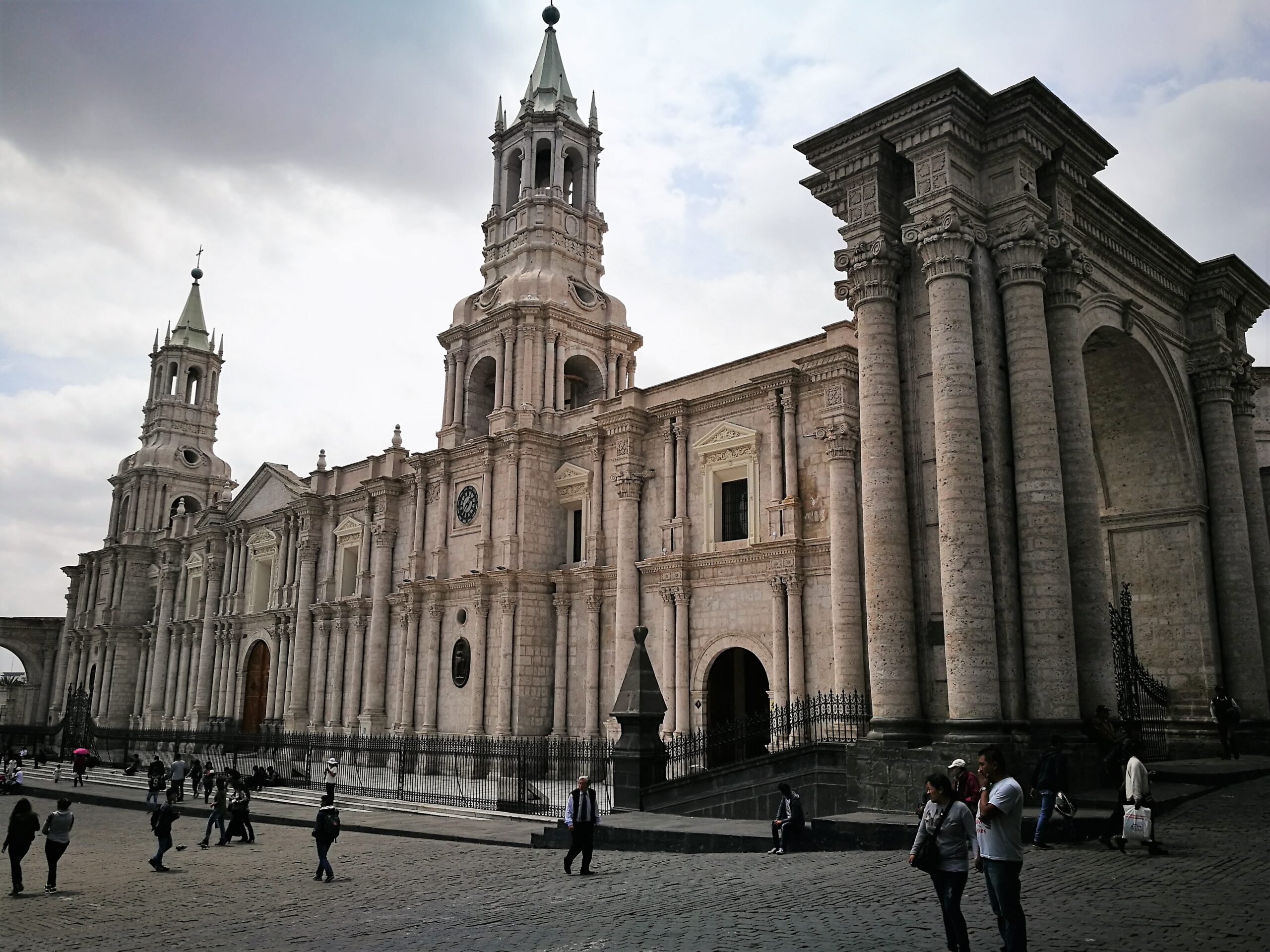
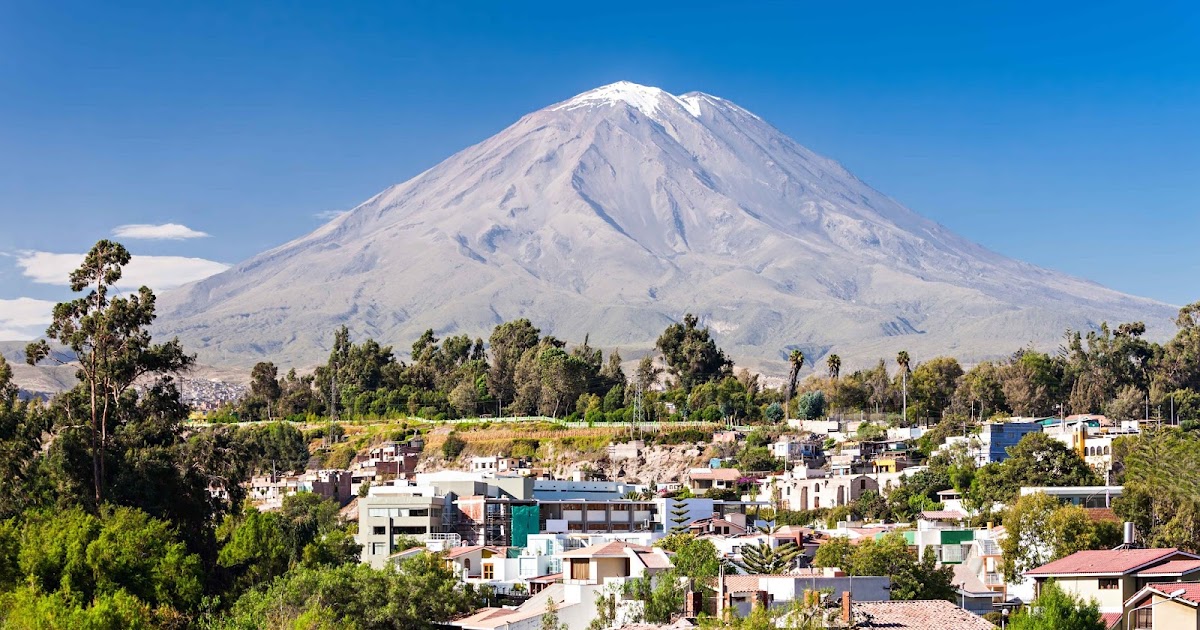
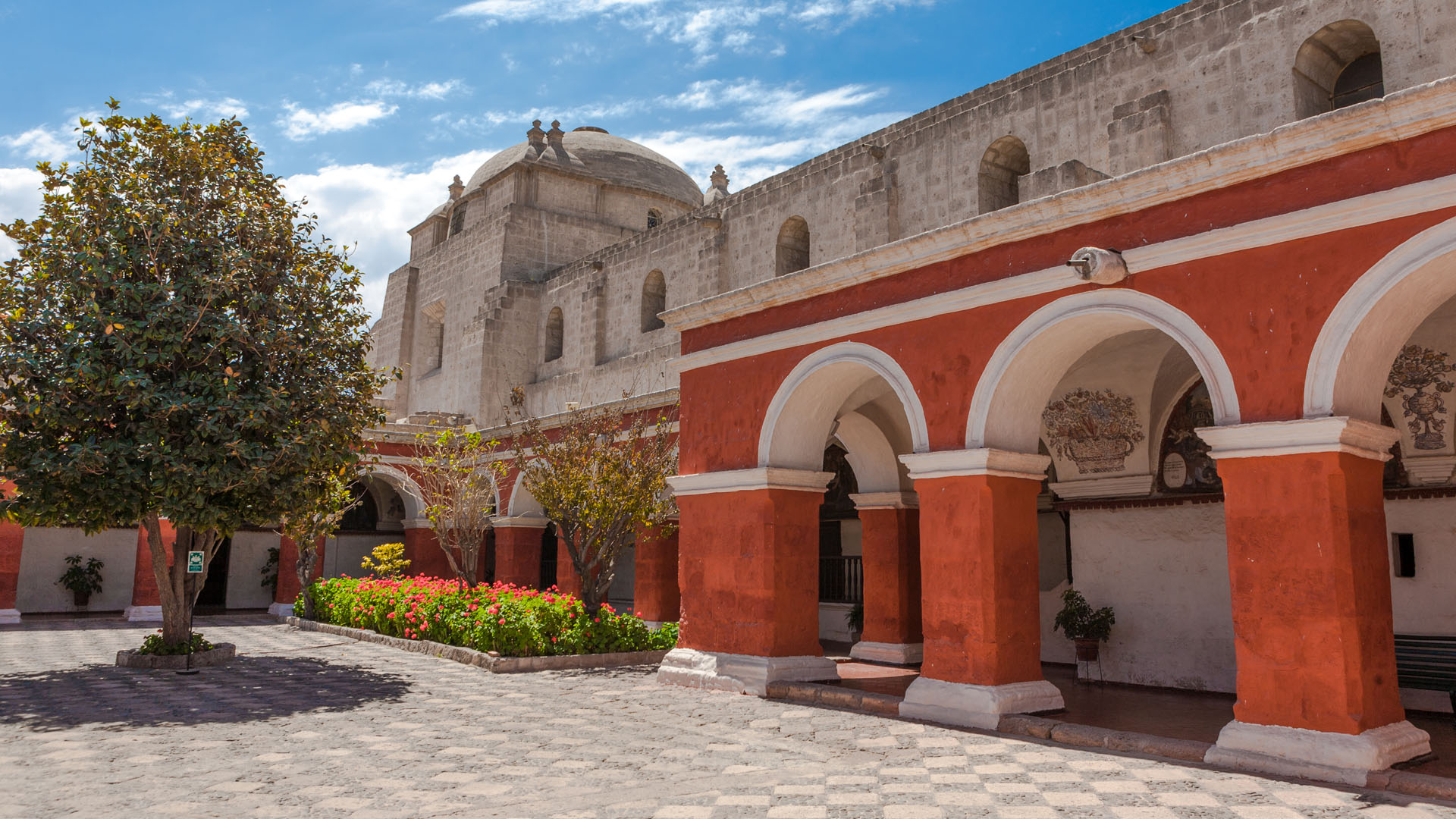
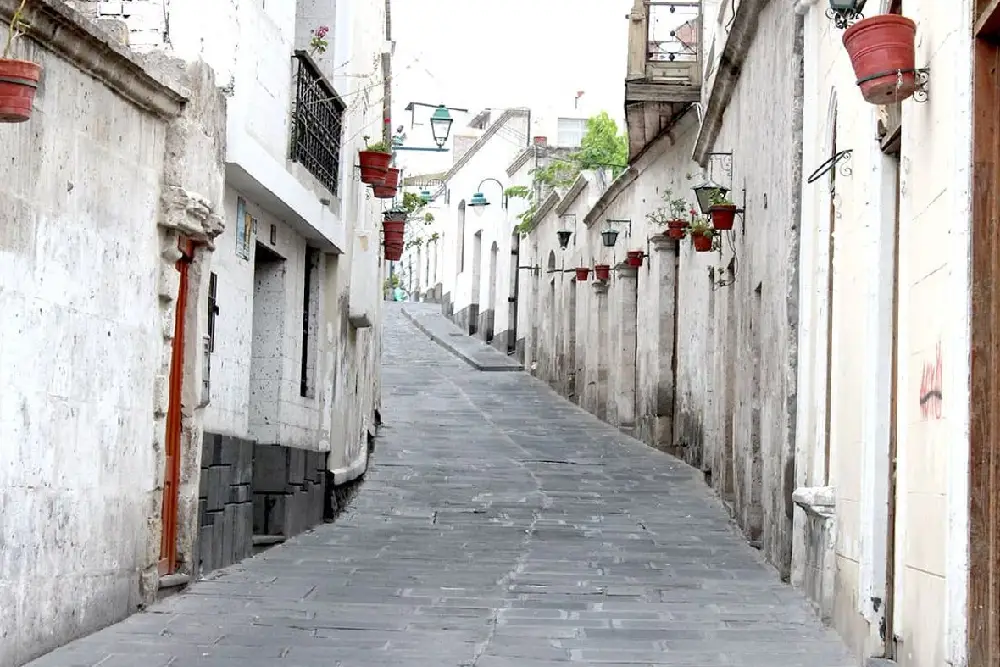
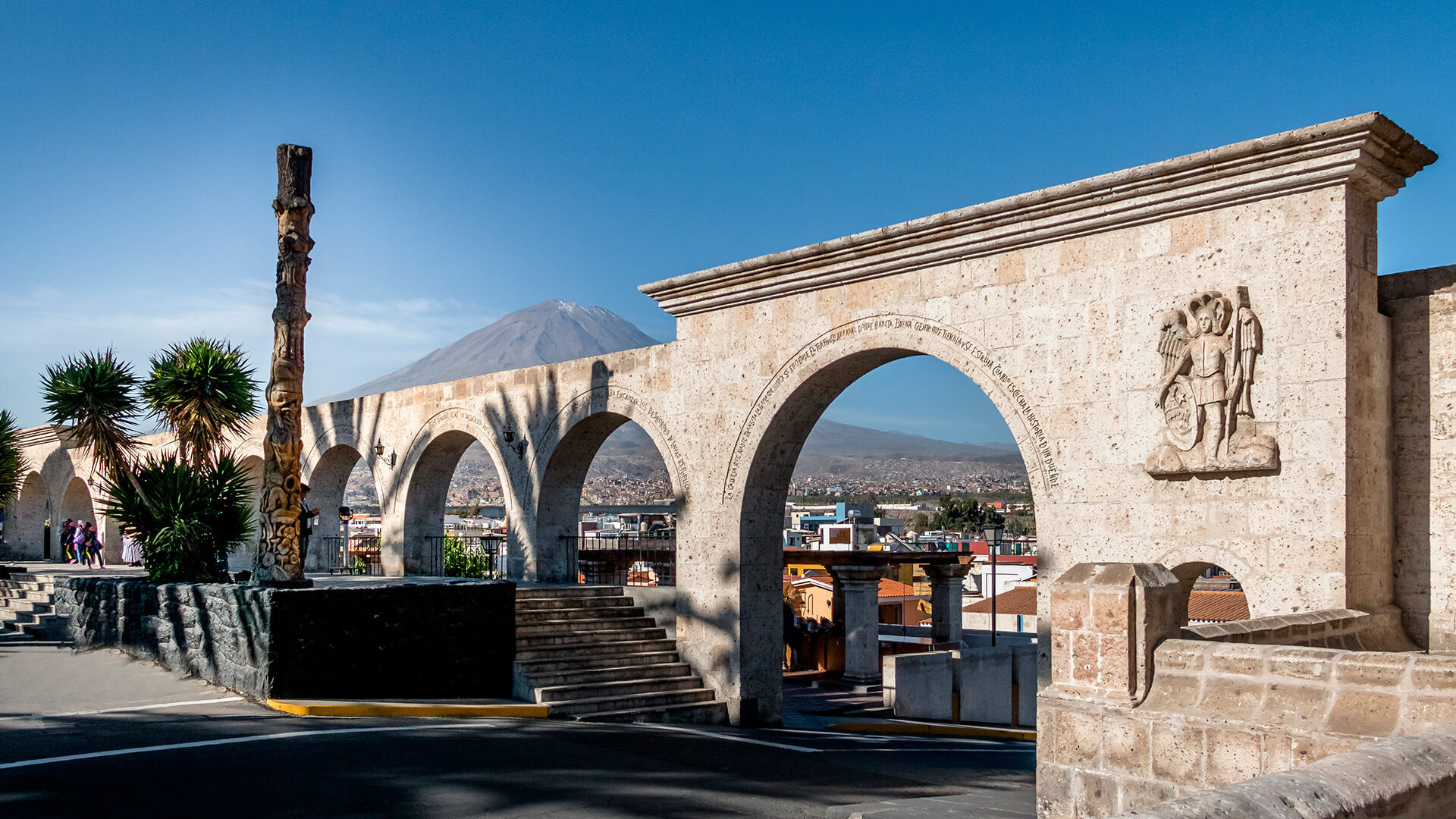


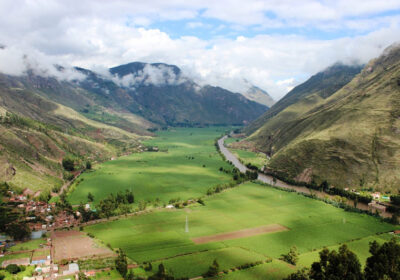

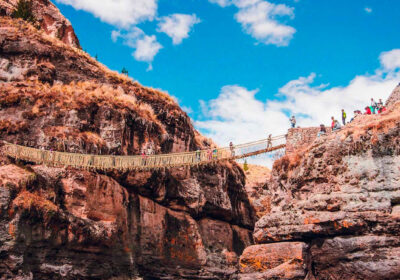
No Comment! Be the first one.